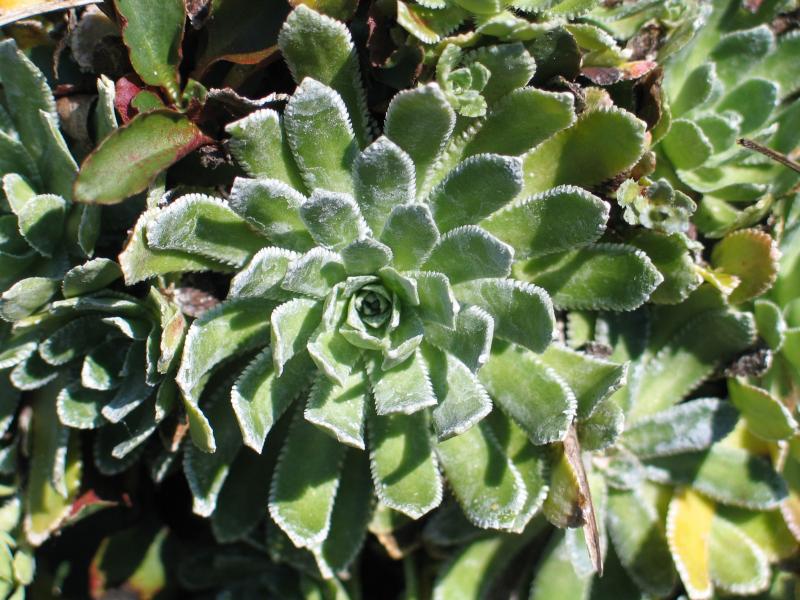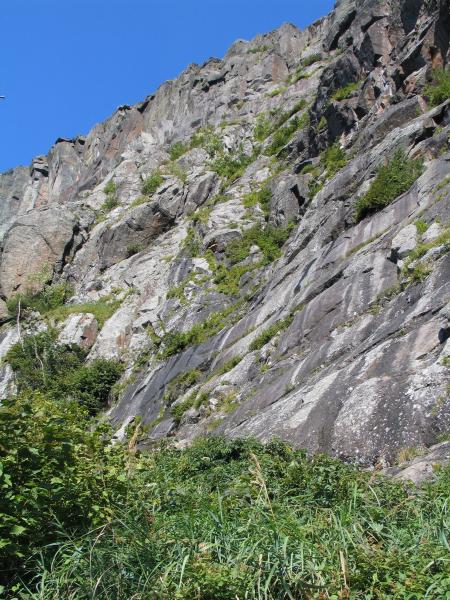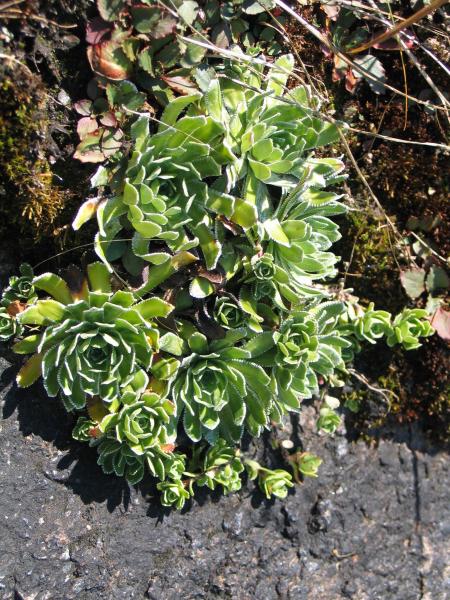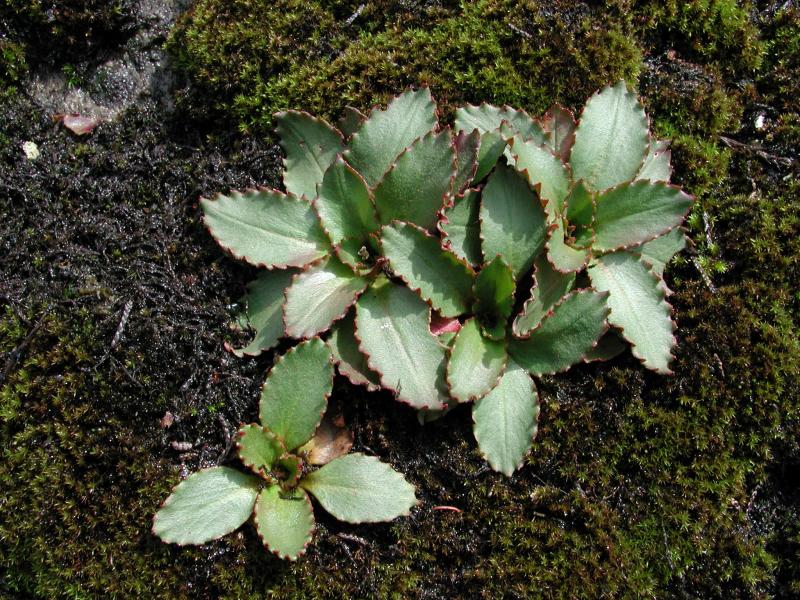White Mountain Saxifrage
Saxifraga paniculata ssp. paniculata None
- Class
- Dicotyledoneae (Dicots)
- Family
- Saxifragaceae (Saxifrage Family)
- State Protection
- Endangered
Listed as Endangered by New York State: in imminent danger of extirpation in New York. For animals, taking, importation, transportation, or possession is prohibited, except under license or permit. For plants, removal or damage without the consent of the landowner is prohibited.
- Federal Protection
- Not Listed
- State Conservation Status Rank
- S1
Critically Imperiled in New York - Especially vulnerable to disappearing from New York due to extreme rarity or other factors; typically 5 or fewer populations or locations in New York, very few individuals, very restricted range, very few remaining acres (or miles of stream), and/or very steep declines.
- Global Conservation Status Rank
- G5TNR
Not Ranked - The global conservation status of this subspecies or variety has not yet been assessed. (The species as a whole is common globally.)
Summary
Did you know?
Special structures known as "hydathodes" secrete liquids from the tips of the basal leaves of White Mountain-saxifrage. The dissolved salts left behind form striking rows of white lime deposits along the leaf margins. In the Arctic, native people traditionally made a "sauerkraut" from the this species by tightly packing the leaves into a sealskin bag and allowing them to ferment (Aiken et al 2003).
State Ranking Justification
There is only 1 verified occurrence in New York, from an isolated cliff face in the Adirondacks. There are 5 historical occurrences, dating back to the 1920s, and all from Essex County.
Short-term Trends
The population of this species at its one known site in New York may have increased in recent years, though accurate estimates are difficult because of the steep cliff habitat.
Long-term Trends
The plants have persisted at one current location since at least 1949; there is at least one historical location which needs to be searched.
Conservation and Management
Threats
Damage to the cliff face by rock climbers, and, over time, climate change, are potential threats to this cliff-dwelling, boreal species.
Habitat
Habitat
The single verified site for New York White Mountain-saxifrage in New York is an immense south to southeast-facing cliff face with a nearly vertical exposure. The plants are growing in the open from rock ledges and cracks the (primarily anorthosite) rock face (New York Natural Heritage Program). Crevices in basic rock along Lake Superior (Voss 1985). Exposed, calcareous gravel and rocks (Haines and Vining 1998).
Associated Ecological Communities
- Calcareous cliff community*
(guide)
A community that occurs on vertical exposures of resistant, calcareous bedrock (such as limestone or dolomite) or consolidated material; these cliffs often include ledges and small areas of talus.
- Cliff community*
(guide)
A community that occurs on vertical exposures of resistant, non-calcareous bedrock (such as quartzite, sandstone, or schist) or consolidated material; these cliffs often include ledges and small areas of talus.
* probable association but not confirmed.
Associated Species
- Achillea millefolium (yarrow)
- Campanula rotundifolia (hare-bell)
- Carex scirpoidea
- Danthonia spicata (poverty grass)
- Dasiphora floribunda
- Deschampsia flexuosa
- Draba arabisans (rock whitlow-grass)
- Houstonia sp.
- Minuartia groenlandica
- Muhlenbergia glomerata (spike muhly)
- Polygonatum pubescens (hairy Solomon's-seal)
- Saxifraga virginiensis
- Solidago macrophylla (large-leaved goldenrod)
- Solidago simplex var. randii
- Spiraea alba var. latifolia (broad-leaved meadow-sweet)
- Trisetum spicatum (narrow oat grass)
- Woodsia ilvensis (rusty woodsia, rusty cliff fern)
Range
New York State Distribution
In New York this species is known only from Essex County in the Adirondacks.
Global Distribution
White-Mountain-saxifrage has a circumboreal distribution. In North America it reaches its southern limit in Northern New England, New York, Michigan, and Minnesota.
Identification Comments
General Description
White Mountain-saxifrage is a perennial herb with rosettes of tightly-packed, fleshy leaves. These basal leaves have finely toothed margins, each tooth bears distinctive white, limy deposits. A central flowering stalk extends 10 to 30 cm up from the center of the rosette, and bears smaller leaves or bracts below several white, 5-petaled flowers 3 to 4 mm long.
Best Life Stage for Proper Identification
The basal rosettes of this species are distinctive enough to permit identification from vegetative as well as flowering material.
Similar Species
The dense basal rosettes with lime-encrusted pores are very distinctive. Saxifraga aizoides also have fleshy basal leaves, but these lack teeth and lime-encrusted pores, a prostrate and mat-forming stems rather than basal rosettes.
Best Time to See
The plants flower in summer but may be identified from vegetative material present any time from May until October.
- Vegetative
- Flowering
- Fruiting
The time of year you would expect to find White Mountain Saxifrage vegetative, flowering, and fruiting in New York.
White Mountain Saxifrage Images
Images of Similar Species
Taxonomy
White Mountain Saxifrage
Saxifraga paniculata ssp. paniculata None
- Kingdom Plantae
- Phylum Anthophyta
- Class Dicotyledoneae
(Dicots)
- Order Rosales
- Family Saxifragaceae (Saxifrage Family)
- Order Rosales
- Class Dicotyledoneae
(Dicots)
- Phylum Anthophyta
Synonyms
- Saxifraga aizoon Jacq.
- Saxifraga paniculata P. Mill.
- Saxifraga paniculata ssp. laestadii (Neuman) Karlsson
- Saxifraga paniculata ssp. neogaea (Butters) D. Löve
Additional Resources
References
Aiken, S.G., M.J. Dallwitz, L.L. Consaul, C.L. McJannet, L.J. Gillespie, R.L. Boles, G.W. Argus, J.M. Gillett, P.J. Scott, R. Elven, M.C. LeBlanc, A.K. Brysting and H. Solstad. 2003. Flora of the Canadian Arctic Archipelago: Descriptions, Illustrations, Identification, and Information Retrieval. Version: 29th April 2003. http://www.mun.ca/biology/delta/arctic
Edinger, Gregory J., D.J. Evans, Shane Gebauer, Timothy G. Howard, David M. Hunt, and Adele M. Olivero (editors). 2002. Ecological Communities of New York State. Second Edition. A revised and expanded edition of Carol Reschke's Ecological Communities of New York State. (Draft for review). New York Natural Heritage Program, New York State Department of Environmental Conservation. Albany, NY. 136 pp.
Fernald, M.L. 1950. Gray's manual of botany. 8th edition. D. Van Nostrand, New York. 1632 pp.
Gleason, H.A., and A. Cronquist. 1991. Manual of vascular plants of northeastern United States and adjacent Canada. New York Botanical Garden, Bronx, New York. 910 pp.
Gleason, Henry A. and A. Cronquist. 1991. Manual of Vascular Plants of Northeastern United States and Adjacent Canada. The New York Botanical Garden, Bronx, New York. 910 pp.
Haines, A. and T.F. Vining. 1998. Flora of Maine, A Manual for Identification of Native and Naturalized Vascular Plants of Maine. V.F.Thomas Co., Bar Harbor, Maine.
Holmgren, Noel. 1998. The Illustrated Companion to Gleason and Cronquist's Manual. Illustrations of the Vascular Plants of Northeastern United States and Adjacent Canada. The New York Botanical Garden, Bronx, New York.
Mitchell, Richard S. 1986. A checklist of New York State plants. Bulletin No. 458. New York State Museum. 272 pp.
New York Natural Heritage Program. 2010. Biotics database. New York Natural Heritage Program. New York State Department of Environmental Conservation. Albany, NY.
New York Natural Heritage Program. 2024. New York Natural Heritage Program Databases. Albany, NY.
Weldy, T. and D. Werier. 2010. New York flora atlas. [S.M. Landry, K.N. Campbell, and L.D. Mabe (original application development), Florida Center for Community Design and Research http://www.fccdr.usf.edu/. University of South Florida http://www.usf.edu/]. New York Flora Association http://newyork.plantatlas.usf.edu/, Albany, New York
Weldy, Troy W. and David Werier. 2005. New York Flora Atlas. [S.M. Landry, K.N. Campbell, and L.D. Mabe (original application development), Florida Center for Community Design and Research. University of South Florida]. New York Flora Association, Albany, NY. Available on the web at (http://newyork.plantatlas.usf.edu/).
Links
About This Guide
Information for this guide was last updated on: December 29, 2008
Please cite this page as:
New York Natural Heritage Program. 2024.
Online Conservation Guide for
Saxifraga paniculata ssp. paniculata.
Available from: https://guides.nynhp.org/white-mountain-saxifrage/.
Accessed July 27, 2024.




